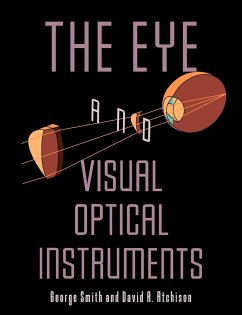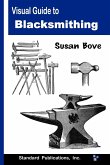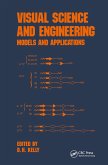- Broschiertes Buch
- Merkliste
- Auf die Merkliste
- Bewerten Bewerten
- Teilen
- Produkt teilen
- Produkterinnerung
- Produkterinnerung
Comprehensive textbook on the design and visual ergonomics of optical instruments.
Andere Kunden interessierten sich auch für
![Visual Guide to Blacksmithing Visual Guide to Blacksmithing]() Susan BoveVisual Guide to Blacksmithing25,99 €
Susan BoveVisual Guide to Blacksmithing25,99 €![Policy Instruments and Co-Regulation for the Sustainability of Value Chains Policy Instruments and Co-Regulation for the Sustainability of Value Chains]() Sergio UgartePolicy Instruments and Co-Regulation for the Sustainability of Value Chains72,99 €
Sergio UgartePolicy Instruments and Co-Regulation for the Sustainability of Value Chains72,99 €![A History of the Logarithmic Slide Rule and Allied Instruments A History of the Logarithmic Slide Rule and Allied Instruments]() Florian CajoriA History of the Logarithmic Slide Rule and Allied Instruments21,99 €
Florian CajoriA History of the Logarithmic Slide Rule and Allied Instruments21,99 €![The Romance of War Inventions; A Description of Warships, Guns, Tanks, Rifles, Bombs, and Other Instruments and Munitions of Warfare, How They Were Invented & How They Are Employed The Romance of War Inventions; A Description of Warships, Guns, Tanks, Rifles, Bombs, and Other Instruments and Munitions of Warfare, How They Were Invented & How They Are Employed]() Thomas W. CorbinThe Romance of War Inventions; A Description of Warships, Guns, Tanks, Rifles, Bombs, and Other Instruments and Munitions of Warfare, How They Were Invented & How They Are Employed24,99 €
Thomas W. CorbinThe Romance of War Inventions; A Description of Warships, Guns, Tanks, Rifles, Bombs, and Other Instruments and Munitions of Warfare, How They Were Invented & How They Are Employed24,99 €![The Visual Factory The Visual Factory]() Michel GreifThe Visual Factory94,99 €
Michel GreifThe Visual Factory94,99 €![Visual Science and Engineering Visual Science and Engineering]() KellyVisual Science and Engineering250,99 €
KellyVisual Science and Engineering250,99 €![Visual Servoing Visual Servoing]() Visual Servoing84,99 €
Visual Servoing84,99 €-
-
-
Comprehensive textbook on the design and visual ergonomics of optical instruments.
Produktdetails
- Produktdetails
- Verlag: Cambridge University Press
- Seitenzahl: 828
- Erscheinungstermin: 15. April 2008
- Englisch
- Abmessung: 246mm x 189mm x 44mm
- Gewicht: 1568g
- ISBN-13: 9780521478205
- ISBN-10: 0521478200
- Artikelnr.: 22270974
- Herstellerkennzeichnung
- Libri GmbH
- Europaallee 1
- 36244 Bad Hersfeld
- gpsr@libri.de
- Verlag: Cambridge University Press
- Seitenzahl: 828
- Erscheinungstermin: 15. April 2008
- Englisch
- Abmessung: 246mm x 189mm x 44mm
- Gewicht: 1568g
- ISBN-13: 9780521478205
- ISBN-10: 0521478200
- Artikelnr.: 22270974
- Herstellerkennzeichnung
- Libri GmbH
- Europaallee 1
- 36244 Bad Hersfeld
- gpsr@libri.de
Preface
Part I. General Theory: 1. Introduction
2. Image formation and ray tracing
3. Paraxial theory of refracting systems
4. Paraxial theory of reflecting systems
5. Non-Gaussian optics
6. Lens types and image formation
7. Mirror types and image formation
8. Prisms
9. Aperture stops, pupils, field lenses, and field stops
10. Defocus, depth-of-field and focussing techniques
11. Optical metrology
12. Photometry of optical systems
Part II. Geometrical Optical Instruments or Systems: 13. The eye
14. Ophthalmic lenses
15. Simple magnifiers
16. Microscopes
17. Telescopes
18. Macroscopes
19. Relay systems
20. Angle and distance measuring instruments
21. Cameras and camera lenses
22. Projectors
23. Collimators
24. Photometers and colorimeters
Part III. Physical Optics and Physical Optical Instruments: 25. Interferometry and interferometers
26. Diffraction and diffractive devices
Part IV. Ophthalmic Instruments: 27. Focimeters
28. Radiuscopes and keratometers
29. Ophthalmoscopes
30. The Badal optometer
31. Optometers
32. Binocular vision and testing instruments
Part V. Aberrations and Image Quality: 33. Aberration theory
34. Image quality
35. Aberrations of the eye
Part VI. Visual Ergonomics: 36. Visual ergonomics of monocular systems
37. Visual ergonomics of binocular systems
Appendices.
Part I. General Theory: 1. Introduction
2. Image formation and ray tracing
3. Paraxial theory of refracting systems
4. Paraxial theory of reflecting systems
5. Non-Gaussian optics
6. Lens types and image formation
7. Mirror types and image formation
8. Prisms
9. Aperture stops, pupils, field lenses, and field stops
10. Defocus, depth-of-field and focussing techniques
11. Optical metrology
12. Photometry of optical systems
Part II. Geometrical Optical Instruments or Systems: 13. The eye
14. Ophthalmic lenses
15. Simple magnifiers
16. Microscopes
17. Telescopes
18. Macroscopes
19. Relay systems
20. Angle and distance measuring instruments
21. Cameras and camera lenses
22. Projectors
23. Collimators
24. Photometers and colorimeters
Part III. Physical Optics and Physical Optical Instruments: 25. Interferometry and interferometers
26. Diffraction and diffractive devices
Part IV. Ophthalmic Instruments: 27. Focimeters
28. Radiuscopes and keratometers
29. Ophthalmoscopes
30. The Badal optometer
31. Optometers
32. Binocular vision and testing instruments
Part V. Aberrations and Image Quality: 33. Aberration theory
34. Image quality
35. Aberrations of the eye
Part VI. Visual Ergonomics: 36. Visual ergonomics of monocular systems
37. Visual ergonomics of binocular systems
Appendices.
Preface
Part I. General Theory: 1. Introduction
2. Image formation and ray tracing
3. Paraxial theory of refracting systems
4. Paraxial theory of reflecting systems
5. Non-Gaussian optics
6. Lens types and image formation
7. Mirror types and image formation
8. Prisms
9. Aperture stops, pupils, field lenses, and field stops
10. Defocus, depth-of-field and focussing techniques
11. Optical metrology
12. Photometry of optical systems
Part II. Geometrical Optical Instruments or Systems: 13. The eye
14. Ophthalmic lenses
15. Simple magnifiers
16. Microscopes
17. Telescopes
18. Macroscopes
19. Relay systems
20. Angle and distance measuring instruments
21. Cameras and camera lenses
22. Projectors
23. Collimators
24. Photometers and colorimeters
Part III. Physical Optics and Physical Optical Instruments: 25. Interferometry and interferometers
26. Diffraction and diffractive devices
Part IV. Ophthalmic Instruments: 27. Focimeters
28. Radiuscopes and keratometers
29. Ophthalmoscopes
30. The Badal optometer
31. Optometers
32. Binocular vision and testing instruments
Part V. Aberrations and Image Quality: 33. Aberration theory
34. Image quality
35. Aberrations of the eye
Part VI. Visual Ergonomics: 36. Visual ergonomics of monocular systems
37. Visual ergonomics of binocular systems
Appendices.
Part I. General Theory: 1. Introduction
2. Image formation and ray tracing
3. Paraxial theory of refracting systems
4. Paraxial theory of reflecting systems
5. Non-Gaussian optics
6. Lens types and image formation
7. Mirror types and image formation
8. Prisms
9. Aperture stops, pupils, field lenses, and field stops
10. Defocus, depth-of-field and focussing techniques
11. Optical metrology
12. Photometry of optical systems
Part II. Geometrical Optical Instruments or Systems: 13. The eye
14. Ophthalmic lenses
15. Simple magnifiers
16. Microscopes
17. Telescopes
18. Macroscopes
19. Relay systems
20. Angle and distance measuring instruments
21. Cameras and camera lenses
22. Projectors
23. Collimators
24. Photometers and colorimeters
Part III. Physical Optics and Physical Optical Instruments: 25. Interferometry and interferometers
26. Diffraction and diffractive devices
Part IV. Ophthalmic Instruments: 27. Focimeters
28. Radiuscopes and keratometers
29. Ophthalmoscopes
30. The Badal optometer
31. Optometers
32. Binocular vision and testing instruments
Part V. Aberrations and Image Quality: 33. Aberration theory
34. Image quality
35. Aberrations of the eye
Part VI. Visual Ergonomics: 36. Visual ergonomics of monocular systems
37. Visual ergonomics of binocular systems
Appendices.









